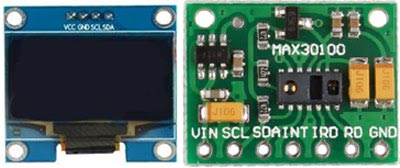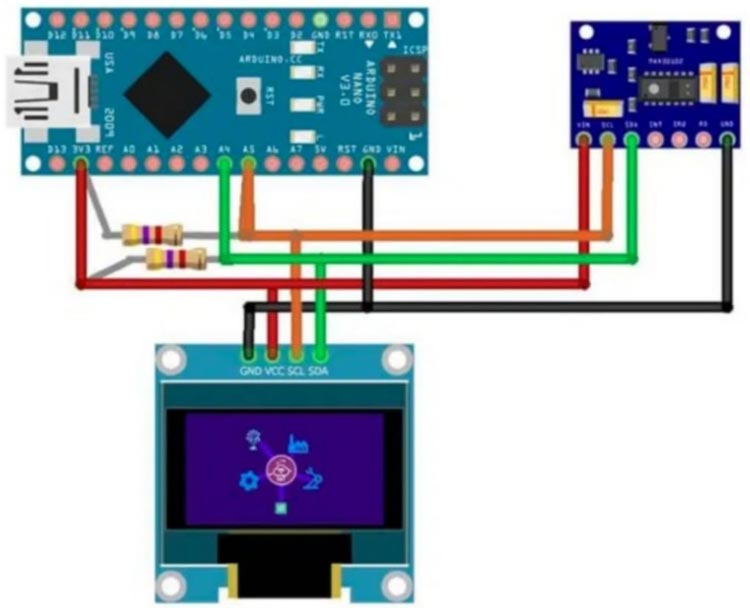Published February 25, 2022
0

I decided to make a 'Pulse Oximeter' because, in this pandemic situation, we need this device a lot. It helps us to measure the BPM(Beats Per Minute) and the percentage of Spo2 of our Body. I used Arduino Nano as the brain of the system. Besides this, I also used a Max 30100 Sensor to measure the BPM and Spo2 with the help of its Optical sensor(IR and red LED combined with a photodetector). Also to monitor the BPM and Spo2 I used a 0.96 inch OLED Display. More ideas can be gleaned from our Arduino projects.
Also check our previous pulse oximeter project:
- MAX30102 Pulse Sensor with Arduino
- IoT Based Heart Rate Monitor
- Arduino Based Pulse Oximeter Sensor Circuit
- Arduino Pulse Sensor
Component Requirement for DIY Pulse Oximeter

Project Used Hardware
- Arduino Nano,
- Max 30100 Sensor,
- 0.96 inch OLED Display
Project Used Software
- Arduino IDE
Project Hardware Software Selection
- 'Arduino Nano': I could use any kind of microcontroller like Arduino UNO, Raspberry Pi Pico, Node MCU, and so on. But I found the Arduino Nano cheaper and smaller than the other ones. Also, it gets the job done properly. So I used this one.
- 'MAX 30100': I used MAX 30100 as the main sensor because it properly maintains the purpose of the device. Because other infrared sensors doesn't work like a charm like this at this price point.
- '0.96 inch OLED Display': First of all this display is small because I wanted to make it portable. Also, this sensor is very easy to work with. Besides these, I also used a Power Bank to power it up. Also, a Lithium Battery could get the job done. And I used the Arduino software because it's the official software of Arduino and also this software is very easy to work with.
Circuit Diagram
Code
#include <Wire.h>
#include "MAX30100_PulseOximeter.h"
#include <Adafruit_GFX.h>
#include <Adafruit_SSD1306.h>
#define ENABLE_MAX30100 1
#define SCREEN_WIDTH 128 // OLED display width, in pixels
#define SCREEN_HEIGHT 32 //64 // OLED display height, in pixels
// Declaration for an SSD1306 display connected to I2C (SDA, SCL pins)
// The pins for I2C are defined by the Wire-library.
// On an arduino UNO: A4(SDA), A5(SCL)
// On an arduino MEGA 2560: 20(SDA), 21(SCL)
// On an arduino LEONARDO: 2(SDA), 3(SCL), ...
#define OLED_RESET 4 // 4 // Reset pin # (or -1 if sharing Arduino reset pin)
#define SCREEN_ADDRESS 0x3C ///< See datasheet for Address; 0x3D for 128x64, 0x3C for 128x32
Adafruit_SSD1306 display(SCREEN_WIDTH, SCREEN_HEIGHT, &Wire, OLED_RESET);
#if ENABLE_MAX30100
#define REPORTING_PERIOD_MS 5000
// PulseOximeter is the higher level interface to the sensor
// it offers:
// * beat detection reporting
// * heart rate calculation
// * SpO2 (oxidation level) calculation
PulseOximeter pox;
#endif
uint32_t tsLastReport = 0;
int xPos = 0;
// Callback (registered below) fired when a pulse is detected
void onBeatDetected()
{
Serial.println("Beat!");
heart_beat(&xPos);
}
void setup()
{
Serial.begin(115200);
Serial.println("SSD1306 128x64 OLED TEST");
// SSD1306_SWITCHCAPVCC = generate display voltage from 3.3V internally
if (!display.begin(SSD1306_SWITCHCAPVCC, SCREEN_ADDRESS)) {
Serial.println(F("SSD1306 allocation failed"));
for (;;); // Don't proceed, loop forever
}
// Show initial display buffer contents on the screen --
// the library initializes this with an Adafruit splash screen.
//display.display();
display.clearDisplay();
display.setTextSize(1);
display.setTextColor(WHITE);
display.setCursor(20, 18);
// Display static text
display.print("Pulse OxiMeter");
int temp1 = 0;
int temp2 = 40;
int temp3 = 80;
heart_beat(&temp1);
heart_beat(&temp2);
heart_beat(&temp3);
xPos = 0;
display.display();
delay(2000); // Pause for 2 seconds
display.cp437(true);
display.clearDisplay();
Serial.print("Initializing pulse oximeter..");
#if ENABLE_MAX30100
// Initialize the PulseOximeter instance
// Failures are generally due to an improper I2C wiring, missing power supply
// or wrong target chip
if (!pox.begin()) {
Serial.println("FAILED");
for (;;);
} else {
Serial.println("SUCCESS");
}
// The default current for the IR LED is 50mA and it could be changed
// by uncommenting the following line. Check MAX30100_Registers.h for all the
// available options.
pox.setIRLedCurrent(MAX30100_LED_CURR_7_6MA);
// Register a callback for the beat detection
pox.setOnBeatDetectedCallback(onBeatDetected);
display_data(0, 0);
#endif
}
void loop()
{
#if ENABLE_MAX30100
// Make sure to call update as fast as possible
pox.update();
int bpm = 0;
int spo2 = 0;
// Asynchronously dump heart rate and oxidation levels to the serial
// For both, a value of 0 means "invalid"
if (millis() - tsLastReport > REPORTING_PERIOD_MS) {
//Serial.print("Heart rate:");
bpm = pox.getHeartRate();
spo2 = pox.getSpO2();
Serial.println(bpm);
//Serial.print("bpm / SpO2:");
Serial.println(spo2);
//Serial.println("%");
tsLastReport = millis();
display_data(bpm, spo2);
}
#endif
drawLine(&xPos);
}
void display_data(int bpm, int spo2) {
display.fillRect(0, 18, 127, 15, BLACK);
//if(bpm ==0 && spo2==0){
// display.setTextSize(1);
// display.setTextColor(WHITE);
//display.setCursor(0, 18);
// Display static text
// display.print("Fingure Out");
//}
display.fillRect(0, 18, 127, 15, BLACK);
display.setTextSize(1);
display.setTextColor(WHITE);
display.setCursor(0, 18);
// Display static text
display.print("BPM ");
display.setTextSize(2);
display.print(bpm);
display.display();
display.setTextSize(1);
display.setTextColor(WHITE);
display.setCursor(64, 18);
// Display static text
display.print("Spo2% ");
display.setTextSize(2);
display.println(spo2);
display.display();
}
void drawLine(int *x_pos) {
// Draw a single pixel in white
display.drawPixel(*x_pos, 8, WHITE);
display.drawPixel((*x_pos)++, 8, WHITE);
display.drawPixel((*x_pos)++, 8, WHITE);
display.drawPixel((*x_pos)++, 8, WHITE);
display.drawPixel((*x_pos), 8, BLACK); // -----
//Serial.println(*x_pos);
display.fillRect(*x_pos, 0, 31, 16, BLACK);
display.display();
//delay(1);
if (*x_pos >= SCREEN_WIDTH) {
*x_pos = 0;
}
}
void heart_beat(int *x_pos) {
/************************************************/
//display.clearDisplay();
display.fillRect(*x_pos, 0, 30, 15, BLACK);
// Draw a single pixel in white
display.drawPixel(*x_pos + 0, 8, WHITE);
display.drawPixel(*x_pos + 1, 8, WHITE);
display.drawPixel(*x_pos + 2, 8, WHITE);
display.drawPixel(*x_pos + 3, 8, WHITE);
display.drawPixel(*x_pos + 4, 8, BLACK); // -----
//display.display();
//delay(1);
display.drawPixel(*x_pos + 5, 7, WHITE);
display.drawPixel(*x_pos + 6, 6, WHITE);
display.drawPixel(*x_pos + 7, 7, WHITE); // .~.
//display.display();
//delay(1);
display.drawPixel(*x_pos + 8, 8, WHITE);
display.drawPixel(*x_pos + 9, 8, WHITE); // --
//display.display();
//delay(1);
/******************************************/
display.drawPixel(*x_pos + 10, 8, WHITE);
display.drawPixel(*x_pos + 10, 9, WHITE);
display.drawPixel(*x_pos + 11, 10, WHITE);
display.drawPixel(*x_pos + 11, 11, WHITE);
//display.display();
//delay(1);
/******************************************/
display.drawPixel(*x_pos + 12, 10, WHITE);
display.drawPixel(*x_pos + 12, 9, WHITE);
display.drawPixel(*x_pos + 12, 8, WHITE);
display.drawPixel(*x_pos + 12, 7, WHITE);
//display.display();
//delay(1);
display.drawPixel(*x_pos + 13, 6, WHITE);
display.drawPixel(*x_pos + 13, 5, WHITE);
display.drawPixel(*x_pos + 13, 4, WHITE);
display.drawPixel(*x_pos + 13, 3, WHITE);
//display.display();
//delay(1);
display.drawPixel(*x_pos + 14, 2, WHITE);
display.drawPixel(*x_pos + 14, 1, WHITE);
display.drawPixel(*x_pos + 14, 0, WHITE);
display.drawPixel(*x_pos + 14, 0, WHITE);
//display.display();
//delay(1);
/******************************************/
display.drawPixel(*x_pos + 15, 0, WHITE);
display.drawPixel(*x_pos + 15, 1, WHITE);
display.drawPixel(*x_pos + 15, 2, WHITE);
display.drawPixel(*x_pos + 15, 3, WHITE);
//display.display();
//delay(1);
display.drawPixel(*x_pos + 15, 4, WHITE);
display.drawPixel(*x_pos + 15, 5, WHITE);
display.drawPixel(*x_pos + 16, 6, WHITE);
display.drawPixel(*x_pos + 16, 7, WHITE);
//display.display();
//delay(1);
display.drawPixel(*x_pos + 16, 8, WHITE);
display.drawPixel(*x_pos + 16, 9, WHITE);
display.drawPixel(*x_pos + 16, 10, WHITE);
display.drawPixel(*x_pos + 16, 11, WHITE);
//display.display();
//delay(1);
display.drawPixel(*x_pos + 17, 12, WHITE);
display.drawPixel(*x_pos + 17, 13, WHITE);
display.drawPixel(*x_pos + 17, 14, WHITE);
display.drawPixel(*x_pos + 17, 15, WHITE);
//display.display();
//delay(1);
display.drawPixel(*x_pos + 18, 15, WHITE);
display.drawPixel(*x_pos + 18, 14, WHITE);
display.drawPixel(*x_pos + 18, 13, WHITE);
display.drawPixel(*x_pos + 18, 12, WHITE);
//display.display();
//delay(1);
display.drawPixel(*x_pos + 19, 11, WHITE);
display.drawPixel(*x_pos + 19, 10, WHITE);
display.drawPixel(*x_pos + 19, 9, WHITE);
display.drawPixel(*x_pos + 19, 8, WHITE);
//display.display();
//delay(1);
/****************************************************/
display.drawPixel(*x_pos + 20, 8, WHITE);
display.drawPixel(*x_pos + 21, 8, WHITE);
//display.display();
//delay(1);
/****************************************************/
display.drawPixel(*x_pos + 22, 7, WHITE);
display.drawPixel(*x_pos + 23, 6, WHITE);
display.drawPixel(*x_pos + 24, 6, WHITE);
display.drawPixel(*x_pos + 25, 7, WHITE);
//display.display();
//delay(1);
/************************************************/
display.drawPixel(*x_pos + 26, 8, WHITE);
display.drawPixel(*x_pos + 27, 8, WHITE);
display.drawPixel(*x_pos + 28, 8, WHITE);
display.drawPixel(*x_pos + 29, 8, WHITE);
display.drawPixel(*x_pos + 30, 8, WHITE); // -----
*x_pos = *x_pos + 30;
display.display();
delay(1);
}Video






